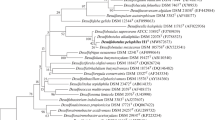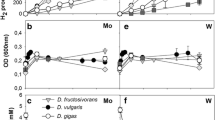Abstract
Uptake of 35S-labelled sulfate was studied with a new isolate of Desulfovibrio desulfuricans, strain CSN. Micromolar additions of sulfate (1–10 μM or nmol/mg protein) to cell suspensions incubated in 150 mM KCl at-1°C were almost completely taken up and accumulated about 5,000-fold. Accumulation was not influenced by incubation in NaCl instead of KCl, by acidic pH (5.5) or by incubation under air for 10 min. In alkaline milieu (pH 8.5), after prolonged contact with air (2 h), or after growth with excess sulfate or thiosulfate as electron acceptor, the amount taken up was diminished approximately by half. Pasteurization inhibited sulfate uptake completely. With increasing concentrations of added sulfate (0.1 to 2.5 mM) the intracellular concentration increased only slowly up to 25 mM, and the accumulation factor decreased down to 8. Sulfate transport was reversible. Accumulated sulfate was rapidly lost from the cells after addition of excess non-labelled sulfate or after addition of the uncoupler carbonyl cyanide m-chlorophenylhydrazone (CCCP). The ATPase inhibitor dicyclohexylcarbodiimide (DCCD) specifically inhibited sulfate reduction but had no immediate influence on sulfate accumulation. Addition of the phosphate analogue arsenate (5 mM) was without effect. These results were not in favour of an ATP-dependent transport system. The K+-H+-antiporter nigericin (in 150 mM KCl) and the Na+-H+-antiporter monensin (in 150 mM NaCl) caused partial inhibition of sulfate accumulation, whereas the K+-transporter valinomycin (in 150 mM KCl) and the Na+-H+ exchange inhibitor amiloride (2 mM) were without effect. The permeant thiocyanate anion (150 mM) inhibited sulfate uptake by 60% at pH 7, and completely at pH 8.5. Although the effects of the different ionophores on the chemiosmotic gradients have not been studied so far, the results indicated that probably both, ΔpH and ΔΨ drive sulfate accumulation and that sulfate is taken up electrogenically in symport with more than 2 protons. The structural sulfate analogues tungstate and molybdate (0.1 mM, each) did not affect sulfate accumulation, although molybdate inhibited sulfate reduction. Chromate completely blocked both of these activities. Sulfite and selenite caused little or no decrease of sulfate accumulation, whereas with thiosulfate and selenate significant inhibition was observed.
Similar content being viewed by others
Abbreviations
- CCCP:
-
carbonyl cyanide m-chlorophenylhydrazone
- DCCD:
-
dicyclohexylcarbodiimide
References
Ames GF-L (1988) Structure and mechanism of bacterial periplasmic transport systems. J Bioenerget Biomembr 20:1–18
Bak F, Cypionka H (1987) A novel type of energy metabolism involving fermentation of inorganic sulphur compounds. Nature 326:891–892
Bak F, Pfennig N (1987) chemolithotrophic growth of Desulfovibrio sulfodismutans sp. nov. by disproportionation of inorganic sulfur compounds. Arch Microbiol 147:184–189
Cuhel RL, Taylor CD, Jannasch HW (1981) Assimilatory sulfur metabolism in marine microorganisms: Characteristics and regulation of sulfate transport in Pseudomonas halodurans and Alteromonas luteo-violaceus. J Bacteriol 147:340–349
Cypionka H (1986) Sulfide-controlled continuous culture of sulfate-reducing bacteria. J Microbiol Meth 5:1–9
Cypionka H (1987) Uptake of sulfate, sulfite and thiosulfate by proton-anion symport in Desulfovibrio desulfuricans. Arch Microbiol 148:144–149
Cypionka H, Pfennig N (1986) Growth yields of Desulfotomaculum orientis with hydrogen in chemostat culture. Arch Microbiol 143:396–399
Cypionka H, Widdel F, Pfennig N (1985) Survival of sulfate-reducting bacteria after oxygen stress, and growth in sulfate-free oxygen-sulfide gradients. FEMS Microbiol Ecol 31:39–45
Deane EM (1975) Sulphate uptake and metabolism in the chrysomonad Monochrysis lutheri. Arch Microbiol 105:295–301
DeLey J (1970) Reexamination of the association between melting point, buoyant density and the chemical base composition of deoxyribonucleic acid. J Bacteriol 101:738–754
Dreyfuss J (1964) Characterization of a sulphate and thiosulphate transporting system in Salmonella typhimurium. J Biol Chem 239:2292–2297
Furlong CE (1987) Osmotic-shock-sensitive transport systems. In: Neidhardt FF (ed) Escherichia coli and Salmonella typhimurium: cellular and molecular biology, ASM, Washington DC, pp 768–796
Furusaka C (1961) Sulphate transport and metabolism by Desulphovibrio desulphuricans. Nature 192:427–429
Jeanjean R, Broda E (1977) Dependence of sulphate uptake by Anacystis nidulans of enery on osmotic shock and on sulphate starvation. Arch Microbiol 114:19–23
Krämer M, Cypionka H (1989) Sulfate formation via ATP sulfurylase in thiosulfate- and sulfite-disproportionating bacteria. Arch Microbiol 151:232–237
Krulwich TA (1983) Na+/H+ antiporters. Biochim Biophys Acta 726:245–264
Marmur J (1961) A procedure for the isolation of deoxyribonucleic acid from micro-organisms. J Mol Biol 3:208–218
McCready RGL, Din GA (1974) Active sulfate transport in Saccharomyces cerevisiae. FEBS Lett 38:361–363
Pardee AB, Prestidge LS, Whipple MB, Dreyfuss J (1966) A binding site for sulfate and its relation to sulfate transport into Salmonella typhimurium. J Biol Chem 241:3962–3969
Postgate JR (1949) Competitive inhibition of sulfate reduction by selenate. Nature 164:670–671
Seitz H-J, Cypionka H (1986) Chemolithotrophic growth of Desulfovibrio desulfuricans with hydrogen coupled to ammonification of nitrate or nitrite. Arch Microbiol 146:63–67
Taylor BF, Oremland RS (1979) Depletion of adenosine triphosphate in Desulfovibrio by oxyanions of group VI elements. Curr Microbiol 3:101–103
Tweedie JW, Segel IH (1970) Specificity of transport processes for sulfur, selenium, and molybdenum anions by filamentous fungi. Biochim Biophys Acta 196:95–106
Utkilen HC, Heldal M, Knutsen G (1976) Characterization of sulphate transport in Anacystis nidulans. Physiol Plant 38:217–220
Vange MS, Holmern K, Nissen P (1974) Multiphasic uptake of sulfate by barley roots. I. Effects of analogues, phosphate and pH. Physiol Plant 31:292–301
Varma A, Schönheit P, Thauer RK (1983) Electrogenic sodium ion/proton antiport in Desulfovibrio vulgaris. Arch Microbiol 136:69–73
Widdel F, Pfennig N (1984) Dissimilatory sulfate- or sulfur-reducing bacteria. In: Krieg NR, Holt JG (eds) Bergey's manual of systematic bacteriology, vol I. Williams & Wilkins, Baltimore London, pp 663–679
Wilson LG, Bandurski RS (1958) Enzymatic reactions involving sulfite, selenate and molybdate. J Biol Chem 233:975–981
Yamamoto LA, Segel IH (1966) The inorganic sulfate transport system of Penicillium chrysogenum. Arch Biochem Biophys 114:525–538
Zehr JP, Oremland RS (1987) Reduction of selenate to selenide by sulfate-respiring bacteria: experiments with cell suspensions and estuarine sediments. Appl Environ Microbiol 53:1365–1369
Author information
Authors and Affiliations
Rights and permissions
About this article
Cite this article
Cypionka, H. Characterization of sulfate transport in Desulfovibrio desulfuricans . Arch. Microbiol. 152, 237–243 (1989). https://doi.org/10.1007/BF00409657
Received:
Accepted:
Issue Date:
DOI: https://doi.org/10.1007/BF00409657




